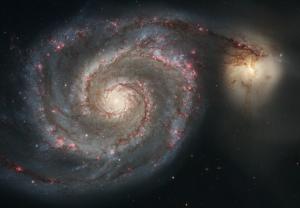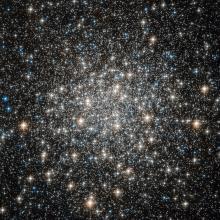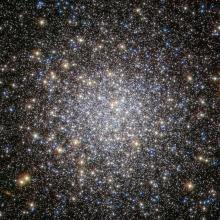The Whirlpool Galaxy, also known as Messier 51, spins through space in this Hubble Space Telescope image. Discovered 250 years ago by French astronomer Charles Messier, the galaxy is interacting with the smaller galaxy at top right. That has pulled great streamers of stars from the bright spiral, and spawned the birth of many new stars, which are seen in the bright red regions. The image also show dark lanes of dust entwined within the galaxy's spiral arms. [NASA/ESA]
You are here
Messier 51
Charles Messier compiled a catalog of “fuzzy” objects in the night sky to help his fellow astronomers discover more comets. But it was while watching a comet that Messier discovered the 51st object on his list.
He found it 250 years ago tonight. He described it as “a very faint nebula, without stars.” Modern telescopes see it as a beautiful spiral galaxy, known as the Whirlpool. It’s about 25 million to 30 million light-years away. It’s a little smaller than our own galaxy, the Milky Way.
M51 actually consists of two galaxies that have sideswiped each other. The close encounter helped create the larger galaxy’s beautiful spiral arms.
The gravity of the smaller galaxy, which looks like a bright knot of stars at the end of one of the larger galaxy’s spiral arms, has created waves that roll around the galaxy’s core. The waves compress clouds of gas and dust, triggering the birth of new stars. Some of the new stars are big, hot, and bright, so they outline the spiral arms.
These young, bright stars don’t last long, though — they explode after a few million years. In fact, three stellar explosions have been seen in M51 in the past few decades, compared to none in the bigger Milky Way. Even as they die, though, the stars are replaced by new ones — the offspring of a galactic encounter.
M51 is just outside Ursa Major, near the tip of the Big Dipper’s handle. It’s an easy target for small telescopes.
Script by Damond Benningfield
Get Premium Audio
Listen to today's episode of StarDate on the web the same day it airs in high-quality streaming audio without any extra ads or announcements. Choose a $8 one-month pass, or listen every day for a year for just $30.






